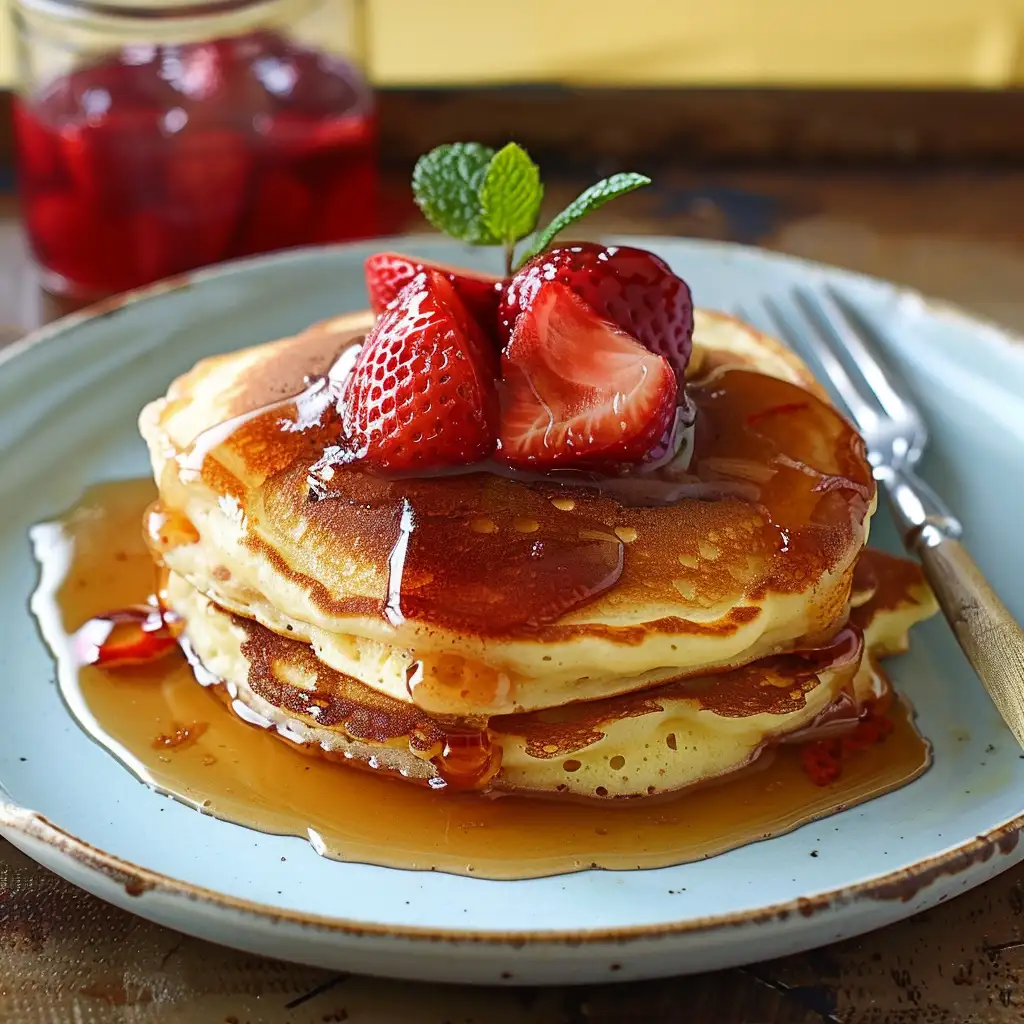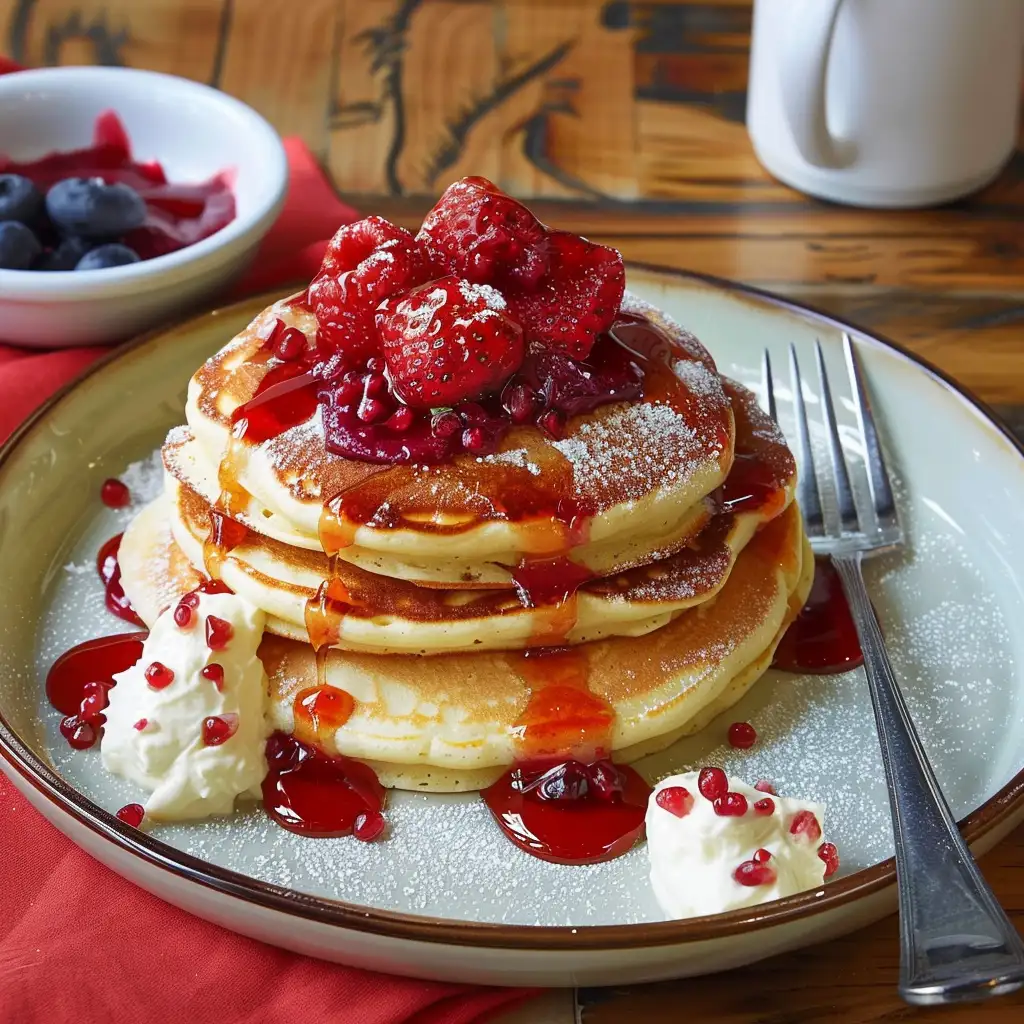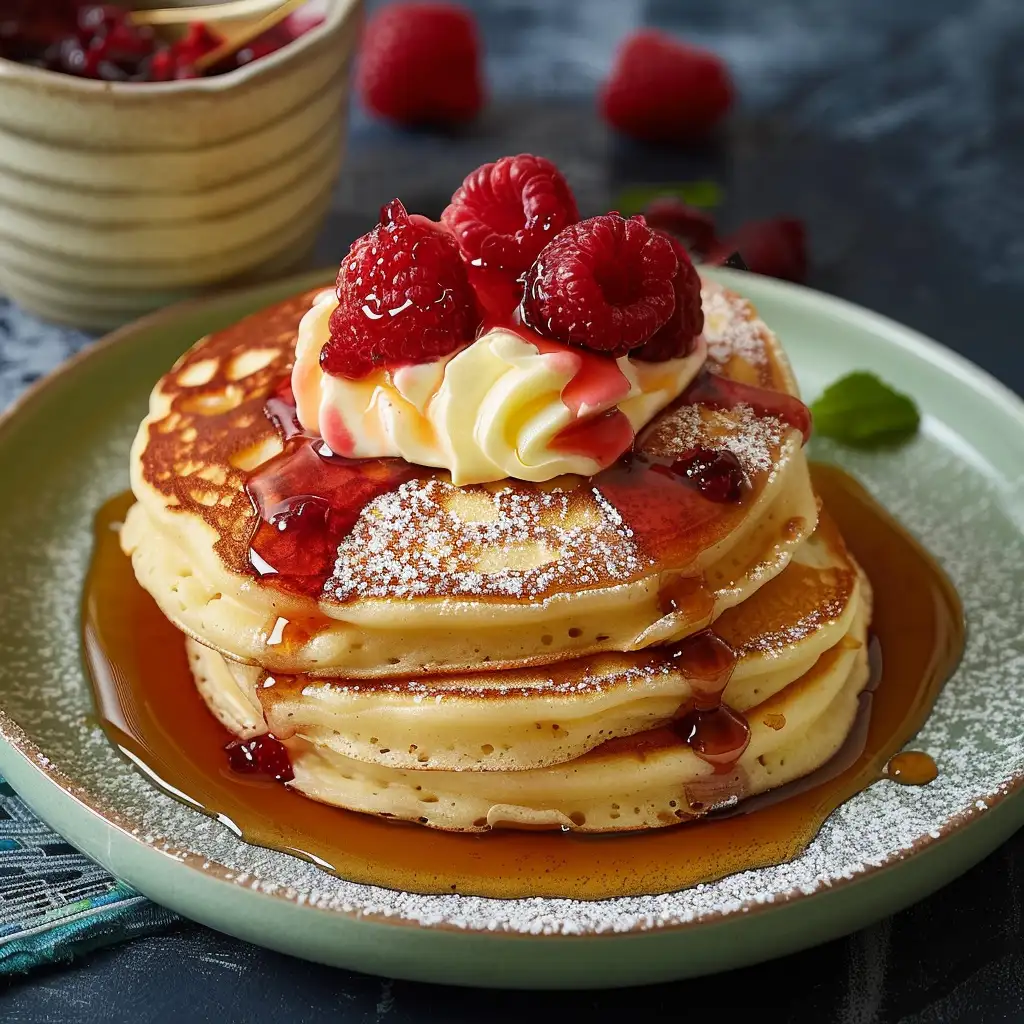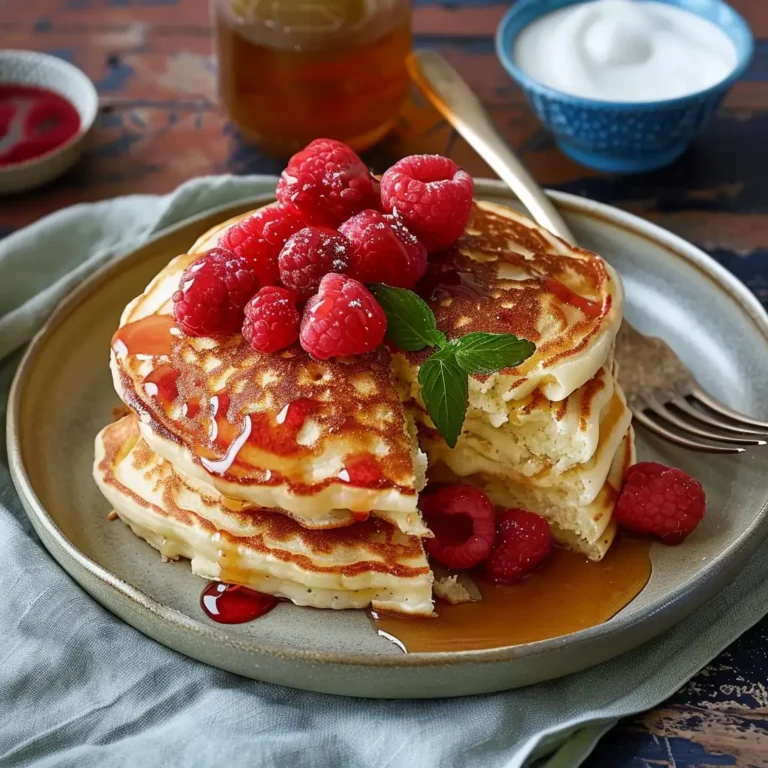Introduction to Cheesecake Pancakes
Pancakes and cheesecakes have long stood as pillars in the world of culinary delights, each with its own rich history dating back centuries. Pancakes, with their origins in the ancient societies of Greece and Rome, have evolved through the ages to become a breakfast staple across the globe. Cheesecakes, believed to have originated on the Greek island of Samos, have charmed their way through time to emerge as a dessert favored for its creamy texture and sweet, tangy flavor.
The fusion dish, Cheesecake Pancakes, represents an innovative culinary synthesis of these two classics, combining the fluffy, tender base of a traditional pancake with the rich, creamy essence of cheesecake. This blend not only creates a unique taste profile but also brings together the best of both worlds in a single serving.
The growing popularity of Cheesecake Pancakes can be attributed to several factors:
- A surge in interest towards gourmet breakfast dishes and dessert-inspired breakfasts.
- The allure of combining dessert and breakfast into one decadent meal.
- The rise of social media platforms, where visually appealing and novel food combinations gain rapid attention and acclaim.
The Perfect Blend of Flavors
Cheesecake Pancakes are more than just a treat for the taste buds; they’re a culinary adventure that brings a novel twist to the breakfast table. What sets this dish apart is not just its innovative concept but the careful selection of ingredients that come together to create its distinctive flavor.
Key components of Cheesecake Pancakes include:
- All-purpose flour and eggs for the pancake base, ensuring a soft, fluffy texture.
- Cream cheese and cheesecake pudding mix, which impart the creamy, tangy flavor reminiscent of classic cheesecake.
- Granulated sugar, baking powder, and baking soda to sweeten and aerate, elevating the overall taste.
The role of the cheesecake pudding mix is particularly noteworthy. Acting as a flavor enhancer, it seamlessly integrates the cheesecake essence into the pancake batter, ensuring that each bite delivers a burst of cheesecake goodness. This ingredient not only simplifies the fusion of flavors but also adds to the pancakes’ moistness, making them irresistibly tender.
In the realm of breakfast and dessert fusion, Cheesecake Pancakes have carved a niche for themselves, celebrated for their delightful blend of flavors and textures. Their uniqueness lies not just in the concept but in the meticulous choice of ingredients, each playing a crucial role in delivering the ultimate gastronomic experience. For those interested in the origins and nutritional value of some of these ingredients, resources like Healthline’s Buttermilk Substitutes and Medical News Today’s Insights on Eggs offer valuable information.

Step-by-Step Recipe for Cheesecake Pancakes
Ingredients List
Creating Cheesecake Pancakes requires a blend of traditional pancake ingredients with a few special additions to infuse that irresistible cheesecake flavor. Here’s what you’ll need:
- Dry Ingredients:
- 2 cups all-purpose flour
- 2 tablespoons granulated sugar
- 2 teaspoons baking powder
- 1 teaspoon baking soda
- ½ teaspoon salt
- 1 box (3.4 oz) cheesecake flavored pudding mix (dry)
- Wet Ingredients:
- 2 cups milk, plus 1 tablespoon divided
- 2 large eggs
- ¼ cup vegetable oil
- For the Filling/Frosting:
- 6 oz cream cheese, at room temperature
- 4 oz butter, at room temperature
- ¾ cup powdered sugar
- Optional Toppings:
- Sliced strawberries
- Graham cracker crumbs
Preparation Guide
Follow these detailed steps to make your Cheesecake Pancakes:
- Combine Dry Ingredients: In a large mixing bowl, whisk together the flour, sugar, baking powder, baking soda, salt, and all but 2 tablespoons of the cheesecake pudding mix. Ensure these ingredients are well combined for a uniform pancake batter.
- Mix Wet Ingredients: In another bowl, beat the eggs, then mix in the milk and vegetable oil. This combination of wet ingredients will help create a smooth, pourable batter.
- Combine Wet and Dry Ingredients: Gradually add the wet mixture to the dry ingredients, stirring until just combined. It’s crucial to avoid overmixing to ensure your pancakes stay fluffy.
- Preheat and Grease: Heat a non-stick skillet or griddle over medium heat and lightly grease with butter or oil. A properly heated pan is key to achieving that golden-brown finish.
- Cook the Pancakes: Pour about ⅓ cup of batter for each pancake onto the skillet. Cook until bubbles form on the surface and the edges look set, then flip and cook until golden brown. This process should take about 2-3 minutes per side.
- Prepare the Filling/Frosting: While the pancakes are cooking, beat together the cream cheese and butter until smooth. Gradually add the powdered sugar and remaining cheesecake pudding mix, beating until creamy. Adjust consistency with the remaining tablespoon of milk if needed.
- Assemble and Serve: Stack the pancakes and spread or pipe the cream cheese filling between each layer. Garnish with optional toppings like sliced strawberries and graham cracker crumbs for extra flavor and texture.
Tips for Achieving the Perfect Fluffiness and Taste
- Don’t Overmix the Batter: Lumps are perfectly fine in pancake batter; overmixing can lead to dense pancakes.
- Let the Batter Rest: Allowing the batter to sit for a few minutes can result in lighter, fluffier pancakes.
- Test for Doneness: Use a toothpick to check if the middle of the pancake is cooked through if you’re unsure.
- Keep Pancakes Warm: Place cooked pancakes on a baking sheet in a warm oven until you’re ready to serve.
For those looking to explore variations or understand more about the role of cream cheese in cooking, the Kitchn’s Guide to Cream Cheese Varieties offers comprehensive insights.
Crafting the perfect Cheesecake Pancakes is about balancing the sweetness of the batter with the tanginess of the cream cheese. By following these steps and tips, you can enjoy a gourmet breakfast that satisfies your sweet tooth while delivering a comforting start to your day.

Customization and Variations for Cheesecake Pancakes
Embracing dietary needs and flavor preferences can make Cheesecake Pancakes a versatile dish that everyone can enjoy. Here’s how to customize your pancakes:
For Dietary Restrictions
- Gluten-Free Options: Swap the all-purpose flour for a gluten-free flour blend. Ensure your cheesecake pudding mix is also gluten-free.
- Vegan Alternatives: Use almond or soy milk instead of regular milk, a vegan cream cheese substitute, and replace eggs with flaxseed or chia seed mix (1 tablespoon of ground flaxseed or chia seeds mixed with 3 tablespoons of water equals one egg).
Flavor Variations
Adding fruit or chocolate can transform the flavor profile of your pancakes:
- Strawberry: Fold in diced strawberries into the batter or use strawberry-flavored cream cheese for the filling.
- Chocolate Chip: Add chocolate chips to the batter for a delightful twist.
- Blueberry: Mix fresh or frozen blueberries into the pancake batter.
Topping and Filling Ideas
- Sprinkle graham cracker crumbs or drizzle chocolate sauce over the top for added texture and sweetness.
- Use whipped cream or fruit compotes as an alternative to cream cheese frosting between layers.
Serving and Presentation
Presentation enhances the dining experience, making even a simple breakfast feel like a luxurious treat.
Plating Cheesecake Pancakes
- Stack the pancakes high on a plate, ensuring each layer of cream cheese frosting peeks out from the sides.
- Garnish with fresh fruit, mint leaves, or a dusting of powdered sugar for a touch of elegance.
- A drizzle of syrup or a dollop of whipped cream can add visual and flavor contrast.
Recommended Side Dishes and Drinks
- Side Dishes: Light, fresh fruit salads or crispy bacon strips complement the richness of the pancakes.
- Drinks: Serve with freshly brewed coffee, tea, or a glass of cold milk. For a more indulgent option, consider a mimosa or a latte.
For additional presentation tips and ideas on how to make your breakfast spread visually appealing, consider exploring resources like Food Network’s Breakfast Plating Techniques.
Customizing your Cheesecake Pancakes not only caters to various dietary needs but also allows for creativity in the kitchen. Whether you’re aiming for a gluten-free option or seeking to dazzle with vibrant flavor additions and toppings, these pancakes offer a canvas for culinary experimentation. When it comes to serving, remember that the visual appeal of your dish can significantly enhance the overall dining experience, turning a simple meal into an unforgettable one.

Nutritional Information
Understanding the nutritional content of Cheesecake Pancakes can help you enjoy this treat while maintaining a balanced diet. Here’s a basic breakdown for one serving (without optional toppings):
- Caloric Count: Approximately 350-400 calories per serving.
- Nutritional Breakdown:
- Carbohydrates: About 45-50g, primarily from flour and sugar.
- Proteins: Roughly 8-10g, coming from eggs and milk.
- Fats: Around 15-20g, with a mix of saturated and unsaturated fats from cream cheese, butter, and vegetable oil.
Remember, adding toppings or fillings will alter these numbers.
FAQs
Can Cheesecake Pancakes be made ahead of time?
Yes, Cheesecake Pancakes can be prepared in advance. Cook the pancakes as directed, allow them to cool, and then store them in an airtight container in the refrigerator for up to 3 days. The cream cheese filling can also be made ahead and stored separately in the fridge. Reheat pancakes in a toaster or oven for best results.
Are there any quick mix alternatives?
For a quicker version, consider using a store-bought pancake mix as the base. Add the cheesecake pudding mix to infuse the cheesecake flavor. Adjust liquid ingredients as needed to match the consistency of the batter described in the original recipe.
How to store leftovers?
Store leftover Cheesecake Pancakes and cream cheese filling separately in airtight containers in the refrigerator. Pancakes can last up to 3 days, while the filling should be used within 5 days. To reheat, gently warm the pancakes in a toaster or oven and the filling in a microwave until just soft enough to spread.
For more detailed nutritional analysis and guidelines on storing different types of food, USDA’s FoodKeeper App provides comprehensive insights and recommendations.
FAQs like these address common concerns, ensuring you can enjoy Cheesecake Pancakes with convenience and confidence, whether you’re preparing them for a leisurely brunch or as an indulgent breakfast treat.

